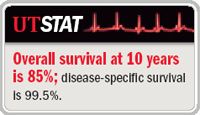Article
PSA kinetics study supports active surveillance
Atlanta-Laurence H. Klotz, MD, looks momentarily at the data generated by his study of the role that PSA kinetics might play in influencing intervention in men with low-risk prostate cancer and summarizes the findings in a single observation: "It is hard to argue with 99% disease-specific survival."

At the AUA annual meeting here, Dr. Klotz, chief of the division of urology at Sunnybrook & Women's College Health Sciences Centre University, Toronto, presented findings on what is widely considered to be the largest and longest study to date on the value of PSA kinetics in determining clinical actions in men with low-risk prostate cancer.
"This study was initiated 10 years ago and evolved from the idea that we were over-treating favorable-risk patients. The idea was to use PSA kinetics and repeat biopsies to identify a subset of these patients who warranted intervention," Dr. Klotz told Urology Times.

The continuing prospective phase II study was initiated in 1995. Findings were presented at earlier intervals on results in cohorts of as many as 300 patients. The current results are based on a cohort of 500 men, 331 of whom have been followed for at least 2 years and 90% of whom are said to have favorable-risk prostate cancer, defined as men having a PSA of ≤10.0 ng/mL, a Gleason ≤ 6, and stage T1c to T2 cancer.
Patients 55 years of age or younger were required to have less than three positive cores on sextant biopsy or no more than three from an 8-to 12-core biopsy and no greater than 50% involvement in any positive core. Men who were estimated to have a life expectancy of less than 10 years also were eligible for active surveillance if they had a Gleason of 3+4 and PSA ≤ 15.0 ng/mL.
The men were followed at 3-month intervals with digital rectal exams and PSA testing. Ultrasound tests were conducted at 6-month intervals; bone scans were conducted in years 1 and 2 and repeated at 2-year intervals. All men were given a repeat biopsy 12 to 18 months after entering the program, then every 3 to 5 years.
Indications for intervention included a PSA doubling time of less than 2 years, a reproducible PSA rise above 8.0 ng/mL, a Gleason of 4+4 or higher, or a doubling of the dimension of identified nodules. During the study, just over one-third (35%) of the men met the criteria for intervention. PSA doubling time prompted intervention in 19% of the overall cohort, grade progression prompted intervention in 7%, and 9% of patients chose intervention despite continuing favorable parameters.
Currently, the median age of men in the study is 67 years. Overall survival at 10 years is 85%, and the disease-specific survival rate is 99.5%.
Three patients in the study have died of metastatic disease. These three patients had PSA doubling times of 7 months, 12 months, and 13 months. All were treated radically within 1 year of diagnosis, developed metastatic disease within a year of treatment, and progressed rapidly to hormone-refractory disease and death.
"There is a continuing debate as to how to use PSA kinetics, whether to use doubling time or velocity," Dr. Klotz said. "We used doubling time for technical reasons. One argument is that baseline PSA reflects prostate volume, perhaps BPH. Thus, PSA becomes a function of prostate volume.





